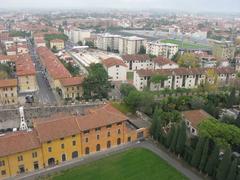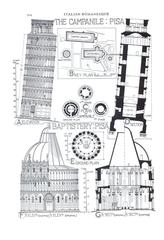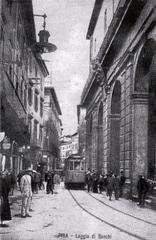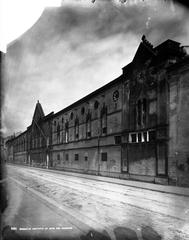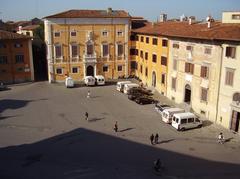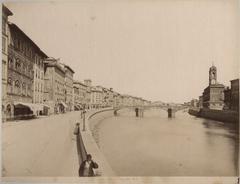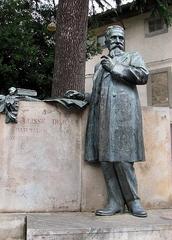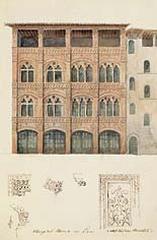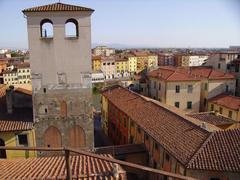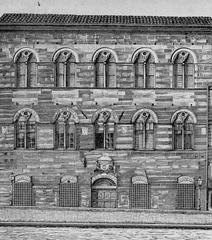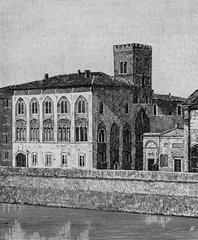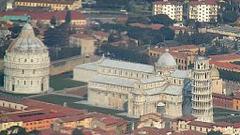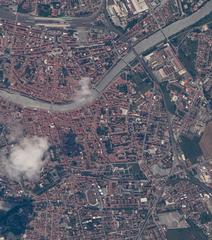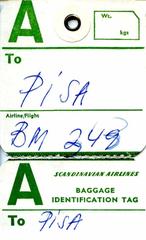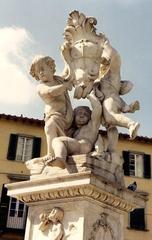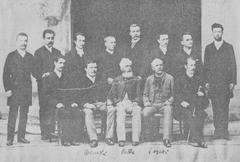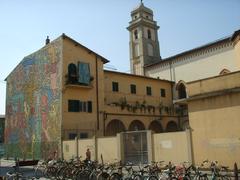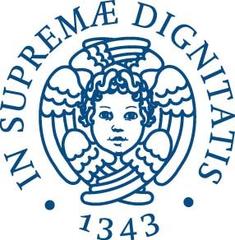Centro Radio di Coltano, Pisa, Italy: Visiting Hours, Tickets, and Historical Site Guide
Date: 15/06/2025
Introduction
Situated just outside the historic city of Pisa, the Centro Radio di Coltano is a landmark in the evolution of global communications and a tribute to the pioneering work of Nobel laureate Guglielmo Marconi. Established in the early 20th century, this groundbreaking radio station was Italy’s first intercontinental wireless hub, playing a pivotal role in connecting the country with its overseas territories and advancing long-distance radiotelegraphy. The site’s marshy terrain was ideal for radio wave propagation, enabling transmissions that marked key milestones in telecommunications (mediasuk.org; unipi.it).
Although the principal buildings, like the Palazzina Marconi, are currently closed due to structural decay, restoration efforts are underway to transform the area into a museum and educational center. Visitors can explore the estate’s grounds, enjoy exhibitions and events at the nearby Villa Medicea, and immerse themselves in the history of both technology and the Tuscan landscape (Il Fatto Quotidiano; QuiNewsPisa).
This guide offers essential information on visiting hours, ticketing, accessibility, restoration progress, and how to best experience one of Pisa’s most unique historical and technological landmarks.
Table of Contents
- Historical Overview and Significance
- Current Physical Condition and Restoration
- Planning Your Visit
- Cultural Heritage & Community Engagement
- Visitor Experience: Practical Information
- Frequently Asked Questions (FAQ)
- Conclusion
- Key Visitor Tips
- References
Historical Overview and Significance
The Genesis of the Centro Radio di Coltano
Approved by the Italian government in 1903 and begun in 1904, the Centro Radio di Coltano was conceived by Guglielmo Marconi and inaugurated in 1911. Its strategic location, chosen for optimal radio wave propagation, enabled transmissions to Italian colonies in Africa and even test contacts as far afield as Canada (mediasuk.org; unipi.it).
Construction and Innovation
The radio station’s infrastructure included the iconic “Palazzina Marconi,” completed in 1910, and a network of massive antennae supported by 250-meter pylons. The technology here was at the global forefront, notably sending the radio signal that illuminated the Christ the Redeemer statue in Rio de Janeiro in 1931 (mediasuk.org).
Wartime and Later Use
During World War I, the Italian Navy took control of the site for military communications. In the decades that followed, expansions and upgrades cemented Coltano’s role as Italy’s international radio gateway. By the 1950s, the facility was adapted for RAI’s radio broadcasts (archive.org).
Legacy
Coltano’s innovations laid the groundwork for advances in wireless, satellite, and cellular communications, making it a key reference point in the history of global technology (iltirreno.it).
Current Physical Condition and Restoration
Site Status
As of June 2025, the main buildings are fenced off and marked by warning signs due to structural hazards. Damage from decades of neglect is visible: collapsed roofs, bricked windows, and graffiti. The 700-square-meter complex retains some original industrial features, but access is restricted for safety (Il Fatto Quotidiano).
Despite this, the surrounding estate and associated heritage structures like the Villa Medicea and Buontalenti stables remain accessible, and the landscape is recognized as both a technological and ecological asset (QuiNewsPisa).
Restoration Efforts
Restoration initiatives have gained momentum, especially after the 150th anniversary of Marconi’s birth in 2024. The Municipality of Pisa has secured funding—an anticipated €7 million from compensatory works and an additional €1 million from the municipal budget—to restore the Centro Radio, Villa Medicea, and other historical structures (Il Fatto Quotidiano). The vision is to create a museum, educational radio station, and cultural hub, with formal property transfer from the state to the municipality imminent.
Community and Cultural Engagement
Local groups, especially Pro Loco Coltano, play a vital role in organizing exhibitions, workshops, and events at Villa Medicea, fostering community stewardship and public awareness (Proloco Coltano; QuiNewsPisa).
Planning Your Visit
Access and Hours
- Centro Radio di Coltano: Currently closed due to restoration and safety concerns. Visitors can view the exterior from safe points.
- Villa Medicea di Coltano: Open for exhibitions and events. Check Proloco Coltano for current hours and guided tour availability.
- Grounds and Trails: The estate and parkland are open for walking and cycling during daylight hours.
Tickets
- Coltano site: No charge for outdoor access.
- Villa Medicea Museum: Free or small donation during events; confirm in advance.
How to Get There
- By Car: About 10–15 km from Pisa, parking available near Villa Medicea.
- By Public Transport: Limited options—check local bus schedules or arrange a taxi from Pisa.
- Cycling: Dedicated traffic-free loops and trails for cyclists.
Accessibility
- The terrain is variable, with some unpaved and uneven paths. Accessibility improvements are planned post-restoration, but visitors with mobility challenges should inquire ahead.
Amenities
- No café or shops on site; bring water and snacks.
- Restrooms available at Villa Medicea during opening hours.
- Nearest facilities are in Coltano village or Pisa city.
Cultural Heritage & Community Engagement
Events and Educational Programs
- Annual Events: “Coltano Radio chiama Futuro,” radio exhibitions, and Marconi commemorations (Storia in Rete).
- Workshops: Educational activities for schools and families.
- Open-air concerts & markets: Celebrate Coltano’s history and local culture (All Events in Pisa).
Sustainable Tourism
- Over 40 km of maintained hiking and cycling trails through the park (Proloco Coltano)
- Visitor programs and volunteer opportunities for conservation and trail maintenance.
Visitor Experience: Practical Information
Safety and Site Etiquette
- The main radio building is off-limits—do not attempt to enter fenced areas.
- Respect ongoing restoration work and local community tranquility.
- Supervise children and avoid unstable structures.
Best Time to Visit
- Spring and autumn offer mild weather and good trail conditions.
- Summer can be hot; winter may bring rain and muddy paths.
Photography and Media
- Photography is allowed and encouraged; drones require prior permission.
- Bring a camera to capture the atmospheric ruins, Villa Medicea, and the natural landscape.
Nearby Attractions
- Pisa City Center: Leaning Tower, Piazza dei Miracoli, Museo della Grafica.
- San Rossore Park: Nature trails and wildlife watching.
- Buontalenti Stables: Part of the ongoing restoration initiative.
Frequently Asked Questions (FAQ)
Q: Can I tour the Centro Radio di Coltano now?
A: No, the main building is currently closed due to safety and restoration. The grounds and Villa Medicea are open for events and guided tours.
Q: How do I book a guided tour?
A: Contact Proloco Coltano or the Municipality of Pisa for up-to-date booking details.
Q: Is the site wheelchair accessible?
A: Accessibility is limited at present but will improve with restoration.
Q: Are there any entrance fees?
A: Outdoor site visits are free; museum entry may require a donation.
Q: Can I bring my bike?
A: Yes, there are cycling trails and loops available on the estate.
Q: What facilities are nearby?
A: Limited amenities on site; nearest services are in Coltano village and Pisa.
Conclusion
The Centro Radio di Coltano is an exceptional site blending technological history, natural beauty, and community spirit. While the main station is presently closed, the surrounding estate, Villa Medicea, and park trails provide a rich, immersive experience. Restoration and community-driven projects are revitalizing this landmark, promising a future where visitors can explore the origins of global wireless communication in a dynamic new museum and cultural center.
Stay informed about restoration progress and event updates through the official Proloco Coltano website and the Audiala app. For a deeper dive into Pisa’s history and regional attractions, see our related travel guides.
Key Visitor Tips
- Check official websites for current opening hours and restoration progress.
- Wear sturdy footwear for uneven terrain.
- Bring water and snacks; facilities are limited.
- Participate in guided tours or community events for a richer experience.
- Respect safety barriers and local etiquette.
References
- Visiting the Centro Radio di Coltano: History, Hours, Tickets & Travel Tips (mediasuk.org)
- Ecco la vera storia della stazione di Marconi a Coltano (unipi.it)
- Guglielmo Marconi 150 anni: la stazione radio di Coltano (iltirreno.it)
- Centro Radio di Coltano Restoration Update: Visiting Hours, Tickets, and Pisa Historical Sites Guide (Il Fatto Quotidiano)
- Pisa al centro del progetto di recupero: c’è Coltano (QuiNewsPisa)
- Coltano, la stazione radiotelegrafica di Guglielmo Marconi (Radio Caffè Criminale)
- Visiting Centro Radio di Coltano: Practical Information and Museum Initiatives (Storia in Rete)
- Alla scoperta della Tenuta di Coltano, Parco Regionale di Migliarino, San Rossore, Massaciuccoli (Parco San Rossore)
- Coltano: nel bosco di notte (All Events in Pisa)
- Museo Marconi Coltano (Proloco Coltano)
- Coltano Capitale della Radio: Dove tutto nacque con Marconi (La Nazione)
